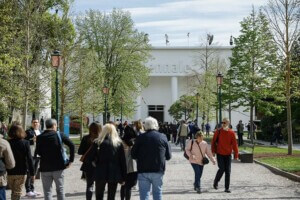Consider the porch: A low-tech structure typically made of wood or stone that plays an oversized role in American culture. From August Wilson’s Pittsburgh, Harper Lee’s Alabama, Spike Lee’s New York, to John Steinbeck’s California; artists lean on porches as literary devices for telling complex stories about civic life, and as liminal spaces that divide our public and private worlds pregnant with meaning.
In all of its literary, political, and cultural dimensions, the porch will take center stage at the U.S. Pavilion in the 2025 Venice Architecture Biennale. PORCH: An Architecture of Generosity will be commissioned and curated by Peter MacKeith, dean of the Fay Jones School at University of Arkansas; Susan Chin, founder of DesignConnects; and Rod Bigelow of Crystal Bridges Museum.
The show which opens May 24, 2025, will focus on “the porch as a central element in American architecture, highlighting its social, environmental, and democratic significance.” It follows the 2023 Venice Architecture Biennale exhibition curated by Cleveland-based SPACES at the U.S. Pavilion which focused on the role plastics play in perpetuating ecological collapse.

An Architecture of Generosity
PORCH, as the title suggests, will deliver a new temporary porch attached to the front of the U.S. Pavilion, completed in 1930 by William Adams Delano. The temporary porch environment will be designed by Marlon Blackwell of Marlon Blackwell Architects; Stephen Burks of Stephen Burks Man Made; Julie Bargmann of D.I.R.T. studio; and Maura Rockcastle of Ten x Ten Landscape Architecture and Urbanism. The Architect’s Newspaper will be the exhibition’s media partner.
More than 50 practices will participate, whose names will be shared in the coming weeks. Timothy Hursley will photograph the exhibition and its accompanying “musical performances, readings, farm-to-table meals, children’s education, social exchanges, craft demonstrations, and educational dialogues.” Apple Seeds Teaching Farm—a nonprofit based in Fayetteville, Arkansas—will provide food at the U.S. Pavilion. Poetry readings and musical performances will take place on Juneteenth and July 4, 2025.
“This exhibition has a very personal dimension for me, but the choice to center porches was arrived at by consensus,” Peter MacKeith told AN. “Myself, Susan Chin, Marlon Blackwell, Rod Bigelow, Julie Bargmann, Maura Rockcastle, Stephen Burks, and Tim Hursley have had lengthy discussions over a long period of time about this theme, and its potential for conveying a broad story about American architecture, and culture.”
Connecting the Dots
Today’s announcement comes three months after chief curator Carlo Ratti shared with AN his overall vision for the 19th International Architecture Exhibition. In May, Ratti said this upcoming biennale, Intelligens, will focus on the city of Venice, Italy, as a testbed for combating climate change. The grand affair will be organized around three key themes: natural intelligence, artificial intelligence, and collective intelligence.
Akin to Ratti’s mentor and philosophical influence, that of Umberto Eco, MacKeith’s thinking is equally impacted by the liberal arts. “Before I studied architecture, I was a student of history and literature,” MacKeith shared. “Look no further than the work of James Agee, Walker Evans, Zora Neale Hurston, or Harper Lee’s To Kill a Mockingbird, the porch has always had such an important role in American literature, music, and storytelling.”
“Porches for us are ways of connecting all these dots, in musical terms, photographic terms, artistic terms, craft traditions like quilts and basket-making, in cuisine, and more generally in architectural terms,” MacKeith elaborated. “I think the central ambition has ultimately been how to best represent not just American architecture, but this sense that American architecture is a social, environmental, and educational construct that incorporates people from many walks of life, and of course, from all over the world.”

Recycle, Repurpose, Reuse
Both the U.S. Pavilion curatorial team and Carlo Ratti share similar sustainability goals. Ratti has said he wants to create an “exhibition that is 100 percent circular where everything we use is reused and recycled.” Thus, after the Venice Architecture Biennale ends, the U.S. Pavilion’s temporary porch will be dismantled and reassembled at school courtyards throughout Venice and Rome for children to interact with.
“My experience with the [Venice] Biennale over a number of years is that, while many adults visit in the first few days and weeks over the course of the summer and into the fall; many visitors are also school children, high school students, and young people in general,” MacKeith continued. “A question we all take seriously is: How do we make this work accessible and valuable to a young person, whether they’re in the 5th grade, or 10th grade?”
Further details about spatial interventions inside and outside the U.S Pavilion will be unveiled in the coming weeks.
The 19th International Architecture Exhibition will be held in Venice from May 24 to November 23, 2025.











